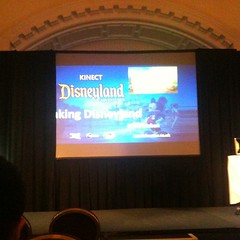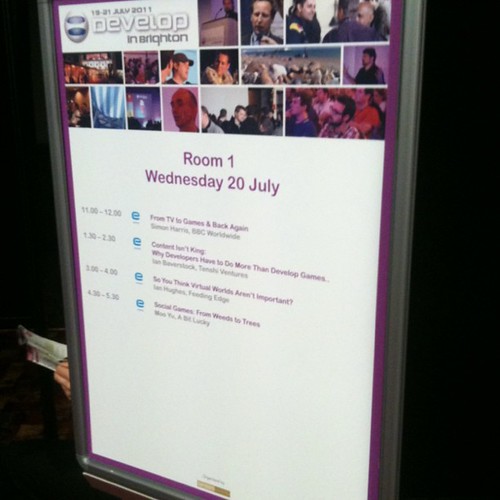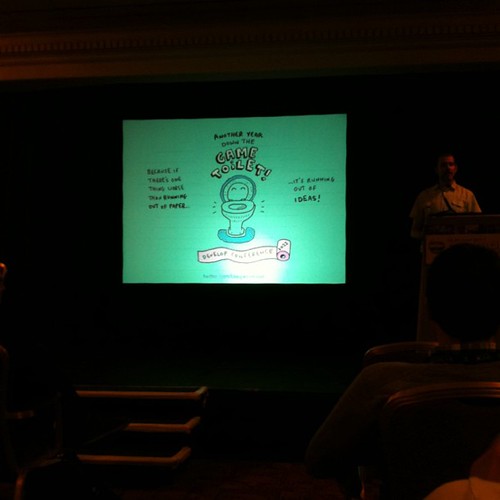In all the google+ messing around I had not got around to writing up my remaining thoughts and experiences at the Developer 2011 conference in Brighton. Day 1 for me was the Evolve conference a sort of future thinking bolt on that is gaining some traction with the industry. The Evolve strand then blends into the next 2 days which are the official Develop conference when everyone else turns up.

Breakfast Serendipity
The day started heading down in the lift from the 6th floor. I was already wearing my badge and a fellow delegate asked me at the lift where the registration desk was. we got chatting and then sat and had breakfast. The usual sort of conference chat, who are you what do you do. The bizzarre thing was that my fellow delegate was called Iain, (I am Ian of course). It also turned out we were both doing a presentation at 3pm that afternoon. This was Iain McCaig who was going to be doing the Art Keynote as an artist and conceptual designer. For those of you who don’t know he has worked on some the biggest movies and characters including creating Darth Maul! of all time. Clearly I was going to lose a “who does the coolest things” competition but we were actually talking about our shared interest in inspiring kids to create. For him it was drawing for me it was tech. We talked about 3d printing a bit too. As he is from the movie biz it was the first time anyone has said in a matter of fact way “yes we use those all the time”. I left breakfast completely inspired and to be speaking some of the same language and ideas as someone so successful gave me a real buzz.
More Media Molecule
In a reprise of last year the opening keynote was the guys from Media Molecule talking about their journey with Little Big Planet. It was done as an interview style with Phil Harrison. For anyone at previous Develops they will have heard many of these stories before. However it is interesting stuff. There was, of course a little more about Phil and Sony’s side of things. The key people who green lit LBP.
TV to Games and Back Again
The next session I popped into was part of the Evolve track, it was also in the room I would pitch in later so it all fitted nicely. Simon Harris of BBC worldwide explained the different approaches BBC Worldwide (the commercial arm of the BBC) is approaching tight integration of TV and games and the various other offline media. In many ways it was similar to the Moshi Monsters direction from the day before. It is not about bolt ons or after thoughts to cash in but about enriched branded experiences. There was a lot about Torchwood and how the growth of this to a US based series was also joined with specific threads being written for episodic games that track and augment the TV show. Top Gear also was very prominent with the deal to weave Top Gear into the Forza 4 experience. Though they did have to get Clarkson to re-record he dialogue as when it went to the certification boards it was not longer a 3+ game but had moved up to teen ranking. The future of the BBC in games and related interesting content seems assured with a lot of focus and investment and this very rich integration. A great session.
Mickey Mouse gaming
The post lunch keynote was the gaming legend David ‘elite’ Braben talking about of all things a virtual world 🙂 There were some amusing moments with the projector, that decided to clip the presentation (which did get sorted. Not a great picture but ‘king Disneyland’ made me laugh anyway.

This virtual world is Frontier’s new game in conjunction with Microsoft and Disney. It is Disneyland adventures. They have completely and perfectly modelled the California disneyland and players are able to wander around the park using where they then join in in rides, quests, minigames etc. This did look very cool though we did see the same attract loop a good few times. David talked about the language of the Kinect and how we are all forming the vocabulary of interaction. In his game you navigate by pointing, but not with a tiring arm out point, but an elbow at your side at 90 degrees movement, using a turn of the shoulders to go left and right. The attention to graphic detail had to be obsessive as this is disney, and being a real place that millions have visited and will visit it had to be a mirror world location.

So you think virtual worlds aren’t important
This was me and my first foray into persuading people in the game industry of the changes brought about by virtual worlds and 3d printing. I gave a live demo of Opensim too. Of course The Cool Stuff Collective features as well as this is validation that if you don’t get this tech and its uses then next generation already are because we are telling them about it. I also dropped in unifier and kitely as examples of services that are evolving to support the demands for virtual worlds. This was very handy as I had an audience question that it was too much messing about to get into a virtual world to have a meeting. My answer was that people are trying to simplify it, but it is also based on demand. if the games industry applied its approaches to running and hosting, and to usability they would have a whole new market to reuse and expand into. They wont do that until they are made aware there is a need.
I also did a straw poll in the room of how many people had heard of the BCS. There was only 1 hand went up which is indicative of the work we have to do to help people in their careers in the games industry.
Raspberry Pi
It was back to David Braben again, this time at the other strand of the conference Games:edu. I already explained a little about this over here. Create a computing device so simple and cheap that allows kids to explore and program. As opposed to just being able to play and consume. This fills the chasm between the creativity of little big planet and other creative tools to the world of computer science. I am very hopeful as whilst we harped back to the 80’s back then we only had the computer to write code on. we did not have the feeder of the creative platforms, the virtual worlds and UGC were not a thing we experienced.
Day 3 – More 3d
Day 3 began rather like day 2 with a reboot of a previous years presentation. This was Mick Hocking of Sony talking about a year of PS3 3D. Last year it was a lot of slides and a quick demo we all had to crowd around. This year we were all in the Odeon with passive 3d specs on. It was a good pitch when we saw examples of design considerations actually played out in 3d. breaking planes, reversing images, forcing convergence and divergence past comfort levels. However a lot of it was 3d powerpoint which was really very annoying. It was a waste of the tech and the time to float bullet points IMHO.
I missed the next session as I was having a few meetings and conversations about beta’s and new tech with people.
Finally the next 2 sessions were the best of the entire conference.
Happily ever after: The Story of one girl’s refusal to delegate
Nat Marco from Honeyslug told a brilliant story of how she was persuaded into learning to code a game in LUA and XML by Ricky. I knew this would be good as I was enthralled at the Kahoots story last year from Honeyslug
How this led to a whole host of remote working relationships with artists around the world producing content for her. She also talked about the relationship with a script writer and how Nat made sure she imposed her own direction and creative will to keep her project how she wanted it to be. It was lighthearted, yet covered some very important points. The team that worked around Nat was global, it was not about co-location. The programming she had to learn was a start, and she saaid it was not as bad as she thought. She was also completely immersed (and supported in that immersion by a publisher) in the project in order to maintain its quality at every stage.
Another year down the gaming toilet
I met Ricky back at the first independent keynote I did at the ACE conference in 2009 and I know we share a lot of the same ideas and humour. Last year he told me I must go to this one particular session. I didn’t get to it but this year I made sure I did as it was running again.

Jerry Carpenter is an artists and developer, he has spent years, each day on a bus on the way to work, writing down short crazy, eccentric and bizarre games ideas. He has a completely different presentation style to anyone else as it kind of rambles, bumbles then hits you square in the eyes with a flash of genius or comedy or both. His inspiration for describing mad/bad games was someone commented one of his games was like watching paint dry. So he made a watching paint dry game that you could only win by sitting watching the paint dry for 24 hours 🙂 So his entire site is now dedicated and full of these brilliant cartoons and succinct ideas for a game. Much of it is NSFW BTW :). I loved 1080 qwerty extreme – a game where you turn you keyboard upside down and stand on it to snowboard, and Ultimate feline optimal area tester (a cat swinging game in a room). The ideas do stand up on their own buy the way he tells about the train of thought had us all in stitches and was brilliant. He should have his own show 🙂 Much of what he shows hits at the heart of some of the terrible grind that is part of social gaming at the moment and is combined with film and political references too. if you get a chance to see him speak please go!
I decided I needed to get back home after that. I could not see anything topping those two sessions for inspiration so I headed on back, collecting all my 3ds spot pass new connections one the way. I look forward to another great conference next year.

Leave a Reply